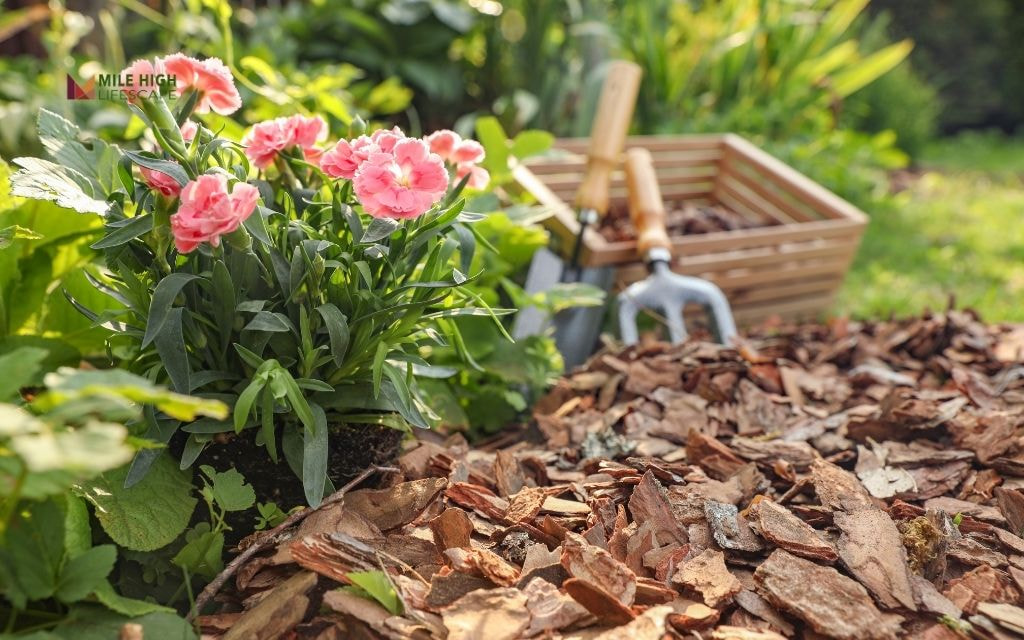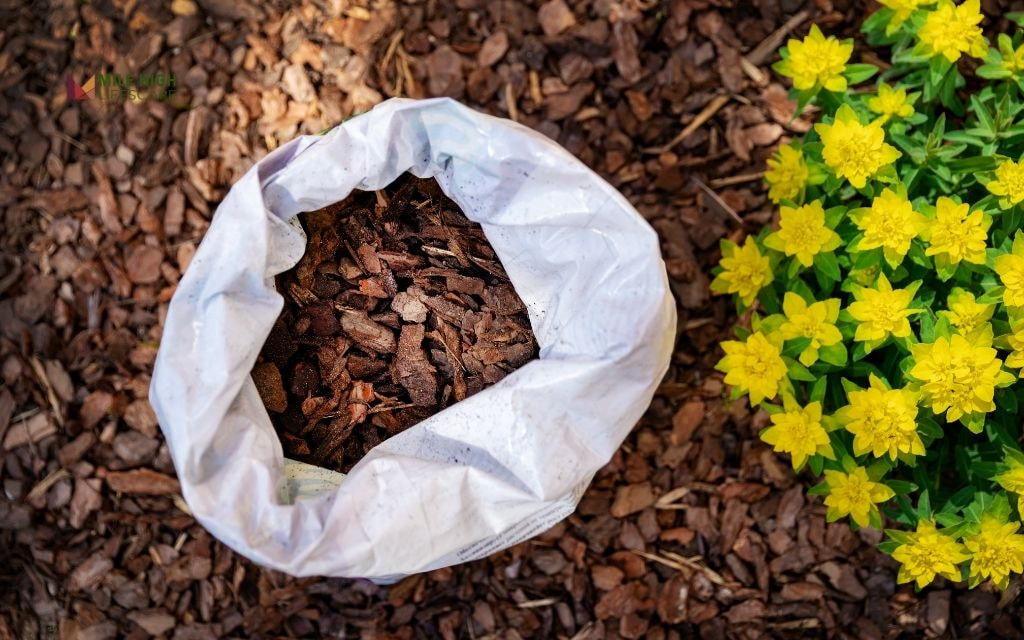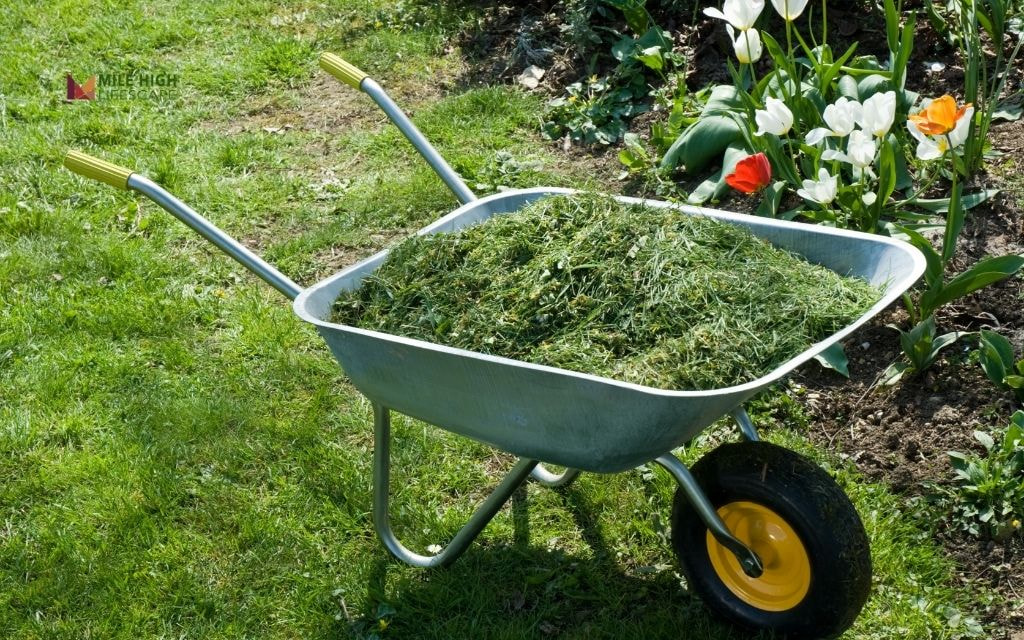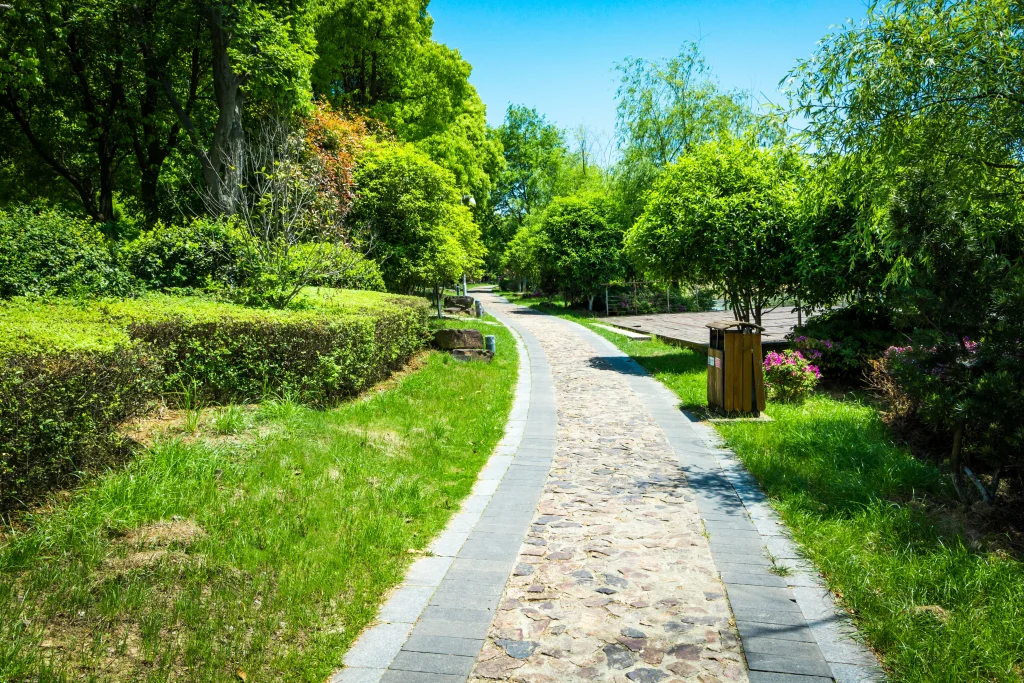How to mulch flower beds in Denver? To effectively mulch flower beds, start by removing weeds and debris. After that, apply a 2-4 inch layer of mulch and make sure it extends to the drip line of the plants.
If you’re a garden lover, you must know mulch. Mulch serves as your garden’s protective shield, offering water conservation, temperature regulation, and weed suppression – essential tools for thriving gardens.
This comprehensive guide covers mulch types suited for Colorado’s Front Range, optimal application timing, step-by-step techniques, winter protection strategies, and Denver-specific professional insights.
Whether you’re maintaining established perennial beds or creating new xeriscaped gardens, proper mulching transforms struggling flower beds into water-smart, low-maintenance landscapes.

How to Mulch Flower Beds: 4 Steps for Easy Gardens
Creating properly mulched flower beds requires systematic preparation and application. Follow these proven techniques used by Denver landscaping professionals to achieve optimal results.
Step 1: Prepare the Flower Bed
Begin by removing all weeds, roots, and debris from your flower bed. Use a sharp-edged spade to cut through persistent weeds at soil level, ensuring complete removal of root systems. Colorado’s clay soil often harbors deep-rooted weeds that resurface without thorough extraction.
Water your flower bed deeply 24 hours before mulching. This pre-watering allows mulch to settle properly and prevents moisture competition between new mulch and established plants. Apply a thin layer of compost or slow-release fertilizer if your plants show nutrient deficiency signs.
Step 2: Choose and Prepare Your Mulch
Select fresh, clean mulch without mold, sour odors, or visible fungal growth.
Denver’s low humidity can preserve contaminated mulch longer than humid climates, making quality selection crucial. Avoid heavily compacted mulches that restrict airflow to plant roots.
Break apart clumped mulch materials and remove any large wood pieces that might create uneven coverage. Quality mulch should feel slightly moist but not waterlogged, with consistent particle size throughout.
Step 3: Apply Mulch Correctly
Spread mulch in a 2-3 inch layer across your flower bed, extending coverage to each plant’s drip line. For fine mulches like compost or shredded leaves, maintain 1-2 inch depth to prevent matting. Create a 2-3 inch mulch-free zone around plant stems and tree trunks to prevent pest harboring and moisture damage.
Use a garden rake to achieve even distribution, working from the center of the bed outward. Smooth any uneven areas while maintaining consistent depth throughout the planting area.
Step 4: Water After Mulching
Apply light watering immediately after mulch application to help materials settle and minimize wind displacement. This initial watering activates the mulch’s moisture-retention properties and begins the beneficial decomposition process that enriches your soil over time.
When is the Best Time to Mulch Flower Beds?
Denver’s climate requires strategic mulching timing to maximize plant protection and water conservation benefits.
Primary Mulching (April-May)
Apply your main mulch layer during late spring after soil temperatures reach 60°F consistently. This timing allows beneficial soil organisms to activate while providing protection against summer heat stress. Late April through mid-May typically offers ideal conditions in the Denver metro area.
Refresh Mulching (August-September)
Inspect mulch depth during late summer and add a light top-off layer if coverage has diminished below 2 inches. Denver’s intense UV exposure and dry winds can break down organic mulches faster than in humid climates.
Winter Protection (October-November)
Apply additional mulch for overwinter protection, increasing depth to 3-4 inches around sensitive perennials and newly planted specimens. Focus extra attention on plants along south-facing exposures where freeze-thaw cycles occur most frequently.

How Often Should You Mulch Flower Beds?
- Refresh your mulch annually to maintain optimal 2-3 inch depth. Denver’s dry climate and intense sunlight break down organic mulches more rapidly than in humid regions, requiring consistent monitoring and replenishment.
- Complete mulch replacement becomes necessary every 2-3 years when materials begin matting or creating water-repellent surfaces. Remove decomposed layers that prevent water penetration before applying fresh mulch.
- Avoid creating “mulch volcanoes” around plant stems or tree trunks. These mounded applications trap moisture against bark, creating conditions for pest infestations and plant diseases common in Colorado’s variable climate.
Types of Mulch for Flower Beds in Denver
| Mulch Type | Best Application | Advantages | Considerations |
| Shredded Bark | Perennial beds, shrub borders | Cost-effective, improves soil as it decomposes | Requires annual replacement, may blow in high winds |
| Wood Chips | Decorative flower beds, pathways | Long-lasting, attractive appearance | Can temporarily reduce soil nitrogen during decomposition |
| Cedar or Cypress | Xeriscape beds, pest-prone areas | Natural pest deterrent, rot-resistant | Higher initial cost, limited local availability |
| Pine Needles | Acid-loving plants, slope stabilization | Lightweight, excellent for erosion control | May disperse in Denver’s strong winds |
| Rock Mulch | Xeriscape zones, high-traffic areas | Permanent solution, wind-resistant | Retains heat, unsuitable for most flowering plants |
Select mulch types based on your specific flower bed conditions and maintenance preferences. Denver’s diverse microclimates – from sunny xeriscape areas to shaded northern exposures – benefit from different mulching approaches.
Why Mulching is Essential for Flower Beds
Colorado’s challenging growing conditions make mulching a necessity rather than an option for successful flower bed management.
- Moisture Conservation During Dry Summers: Denver receives only 15 inches of annual precipitation, with most falling during spring months. Proper mulching reduces evaporation by up to 70%, extending the effectiveness of your irrigation system and reducing water bills significantly.
- Protection Against Freeze-Thaw Damage: Colorado’s dramatic temperature fluctuations can damage plant roots through repeated freezing and thawing cycles. Mulch insulates soil, maintaining stable root zone temperatures even during extreme weather events.
- Improved Soil Structure and Organic Matter: Denver’s clay-heavy soils benefit from organic mulch decomposition. This natural process adds essential organic matter, improving drainage in compacted areas while increasing water retention in sandy soils.
- Weed Suppression for Invasive Species Control: Colorado battles numerous invasive plant species that compete aggressively with desirable flowers. A proper mulch layer blocks sunlight from weed seeds while making manual removal easier when weeds do emerge.
- Soil Temperature Regulation: Mulched soil maintains more consistent temperatures, protecting plant roots from heat stress during summer and preventing premature emergence during warm winter spells followed by late freezes.
- Erosion Control on Sloped Properties: Many Denver properties feature sloped terrain where soil erosion threatens flower bed stability. Mulch binds soil particles and slows water runoff, preserving your garden investment during heavy spring rains.
How to Re-Mulch Flower Beds (Maintenance Refresh)
Maintaining existing mulch layers requires less material and effort than complete replacement while preserving plant health benefits.
- Lightly rake existing mulch to break up any crusted or matted surfaces that prevent water penetration.
- Add a ½ to 1-inch layer of fresh mulch over the existing material to restore optimal depth.
- Focus additional material around plants showing stress signs or areas where original mulch has decomposed completely.
- Remove any seriously decomposed or pest-infested mulch before adding fresh material.
- Soggy, blackened mulch often harbors harmful fungi or provides breeding habitat for garden pests common in Colorado.

Pro Mulching Tips for Denver Gardens
Professional landscapers in Denver employ specific techniques that maximize mulching benefits while avoiding common regional problems.
- Avoid Synthetic Weed Barriers: Skip landscape fabric or plastic sheeting under mulch layers. These materials create water runoff problems in Denver’s clay soils and prevent beneficial soil organisms from accessing organic matter.
- Source Local Materials: Utilize Denver recycling centers, Resource Central, or local certified arborists for economical, appropriate mulch sources. Local materials adapt better to regional climate conditions and support community sustainability efforts.
- Strategic Rock Mulch Application: Reserve rock mulch exclusively for xeriscape zones requiring minimal water input. Rock mulch retains excessive heat for most flowering plants and provides no soil improvement benefits.
- Monitor for Pest Activity: Watch for earwig populations in overly thick mulch layers. These pests thrive in dense organic material and can damage tender flower shoots, particularly in Denver’s protected microclimates.
- Install Proper Edging: Use brick, stone, or steel edging to contain mulch and prevent migration during Denver’s frequent high wind events. Proper edging maintains clean bed lines while protecting adjacent turf areas.
Conclusion
Successful flower bed mulching combines proper timing, appropriate material selection, and correct application depth to create healthier, lower-maintenance landscapes. These three elements work together to conserve precious water, regulate soil temperatures, and suppress persistent Colorado weeds.
Mulching represents one of the simplest yet most effective improvements you can make to your Front Range garden. The investment in quality materials and proper application pays dividends through reduced watering requirements, improved plant health, and enhanced garden aesthetics year-round.
If you’re looking for a “flower bed installation near me”, Mile High Lifescape is the go-to choice in the Denver Metro Area.
We bring decades of Denver-area expertise to water-smart gardening solutions. Our local knowledge ensures your flower beds thrive in Colorado’s unique climate challenges.
Contact us at (303) 877-9091!
Frequently Asked Questions (FAQs)
What is the 3 3 3 mulch rule?
No, the 3 3 3 rule doesn’t apply to Denver flower beds. This guideline suggests 3 inches deep, 3 inches from plant stems, refreshed every 3 years. However, Denver’s arid climate requires 2-3 inches depth, 2-3 inches from stems, and annual refreshing due to faster decomposition from intense UV exposure.
How much mulch is too much?
Yes, more than 4 inches becomes problematic in Denver flower beds. Excessive mulch depth prevents water penetration through our clay soils and creates anaerobic conditions that harm plant roots. Stick to 2-3 inches for optimal water infiltration and root health.
Do you need to remove old mulch before putting down new?
No, complete removal isn’t necessary annually. Simply rake existing mulch to break up crusted surfaces, then add fresh material to restore proper depth. Full removal becomes necessary every 2-3 years when old mulch forms water-repellent mats or harbors pests.
Is rock mulch better for water conservation?
No, rock mulch isn’t ideal for most flower beds despite excellent water retention. While rock mulch prevents evaporation, it retains excessive heat that stresses flowering plants and provides no soil improvement benefits. Reserve rock mulch for xeriscape areas with heat-tolerant plants.
What not to do when mulching?
Yes, avoid these common mistakes: Never pile mulch against plant stems (“mulch volcanoes”), don’t use landscape fabric underneath, avoid applying mulch to frozen or completely dry soil, and don’t use fresh wood chips directly around plants without composting first.
